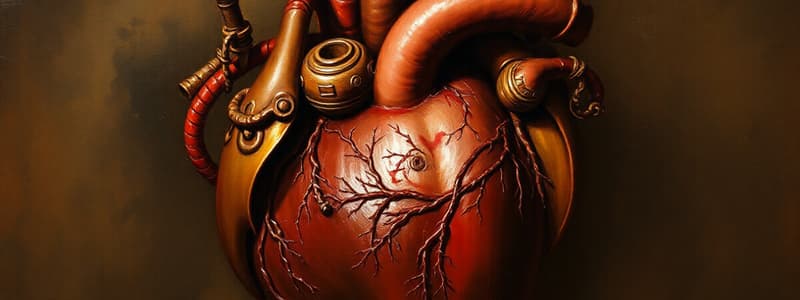Podcast
Questions and Answers
Quo es le localisation del valva pulmonar?
Quo es le localisation del valva pulmonar?
- 2 ICS left sternum (correct)
- 2 ICS right sternum
- 4 ICS left sternum
- 5 ICS left mid-clavicular
Quo facte causa le formate dilatate in cardiomyopathy?
Quo facte causa le formate dilatate in cardiomyopathy?
- Gene mutation
- Pression augmentate
- Stiff musculature
- Accumulation de proteine (correct)
Quo es un symptom importante de cardiomyopathy restricte?
Quo es un symptom importante de cardiomyopathy restricte?
- Fatigue (correct)
- Sudden syncope
- Angina
- Cyanosis
Quo es le treatment initial principal pro insufficiente cardiaca?
Quo es le treatment initial principal pro insufficiente cardiaca?
Quo precaution deve esser observate in patients con cardiomyopathy?
Quo precaution deve esser observate in patients con cardiomyopathy?
Flashcards are hidden until you start studying
Study Notes
Cardiac Valves
- Aortic valve location: Second intercostal space (ICS) right of the sternum
- Pulmonic valve location: Second ICS left of the sternum
- Tricuspid valve location: Fourth ICS left of the sternum
- Mitral valve location: Fifth ICS left mid-clavicular line
- Erbs point is situated at the third ICS left of the sternum, here aortic and pulmonic regurgitation are heard
Cardiomyopathy: Dilated
- Dilated cardiomyopathy is characterized by a decrease in oxygen levels (↓O₂)
- Symptoms include restlessness, agitation, shortness of breath, fatigue, angina, and heart block
- It's caused by heart failure, where the heart doesn't pump blood forward effectively.
- Dilated cardiomyopathy affects the left ventricle, resulting in lung-related signs like crackles and pulmonary edema.
- It also affects the right ventricle, leading to edema, ascites, and jugular venous distention (JVD)
- Tricuspid and bicuspid regurgitation can occur, leading to a narrow pulse pressure due to a reduced ejection fraction.
Cardiomyopathy: Restrictive
- Restrictive cardiomyopathy involves stiff heart muscles that don't stretch properly, leading to problems with heart filling.
- Scar tissue formation also hinders proper blood flow and filling.
- Reduced blood inflow results in reduced blood outflow
- Symptoms include decreased oxygen levels, fatigue, and shortness of breath.
Heart Failure
- Heart failure can be caused by Amyloidosis, a build-up of abnormal proteins
- Sarcoidosis, a disorder characterized by inflamed cell deposits, can also lead to heart failure.
- Hemochromatosis, an iron overload disorder, can contribute to heart failure.
- Radiation therapy to the heart can also cause heart failure
Genetic hypertrophic cardiomyopathy
- Genetic hypertrophic cardiomyopathy is caused by genetic mutations
- Thickened heart muscle walls, particularly the septum, are characteristic of this condition.
- Reduced blood inflow and outflow occur as a result of the thickened septum.
- The thickened septum can obstruct the aortic valve.
- Strain during exercise can worsen symptoms.
- Individuals are often asymptomatic until they experience sudden strain on the heart.
- Decreased oxygen levels lead to symptoms like shortness of breath, fatigue, weakness, syncope, altered level of consciousness, and chest pain.
Diagnosis and Treatment
- Diagnosis involves detecting a heart murmur and utilizing an electrocardiogram (ECG)
- Treatment involves beta-blockers, calcium channel blockers (CCB, like Verapamil), digoxin, antiarrhythmic drugs, diuretics, and vasodilators.
- These medications are aimed at treating the underlying cause of the conditions.
- First-line treatment includes beta-blockers, CCB, digoxin, anti-dysrhythmic drugs, diuretics, and vasodilators.
- Potential treatments include heart transplantation, surgical myectomy (widening the septum), and alcohol ablation (remodeling the septum).
Precautions
- Patients with these conditions should avoid activities that put strain on the heart, like lifting heavy weights, straining during bowel movements, and sudden changes in positions.
Studying That Suits You
Use AI to generate personalized quizzes and flashcards to suit your learning preferences.




